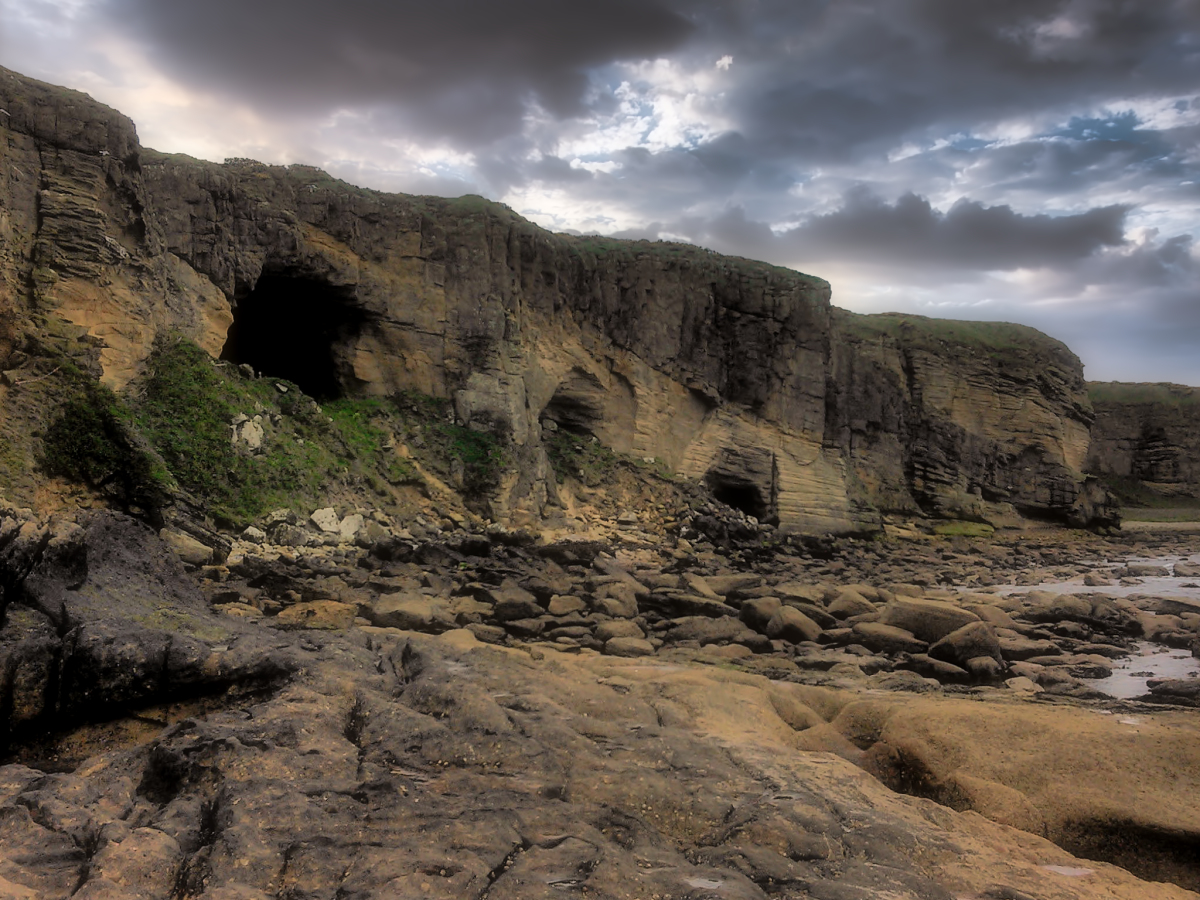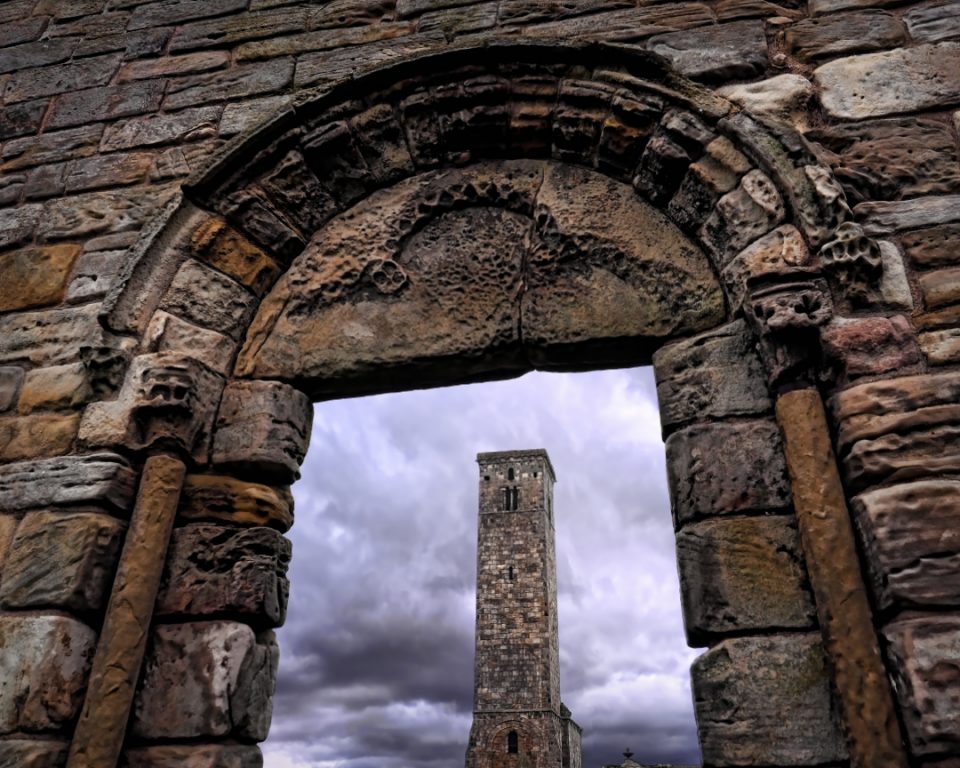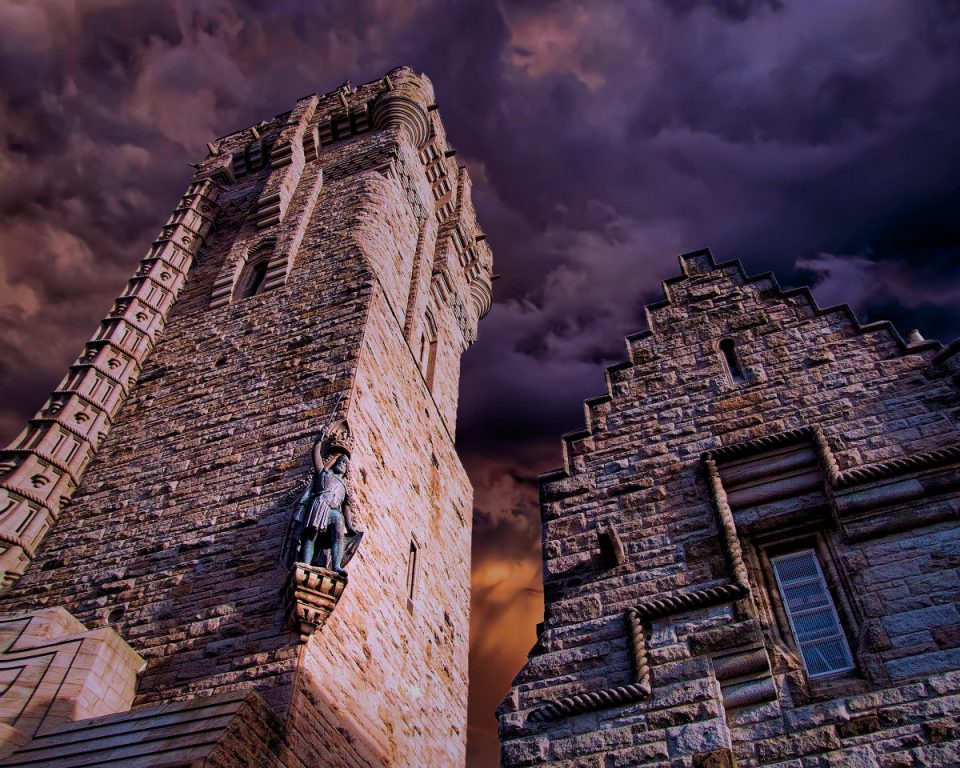Sculptor’s Cave would have come into view as the boat sailed towards the cove. Perhaps there were several boats. Sitting at the foot of the soaring sandstone cliffs, Sculptor’s Cave has two parallel passageways which open into a large chamber area. But Sculptor’s Cove was not the only cave along the stretch of coast at Covesea (pronounced ‘cow-sea’). These caves were well known. They had been used since the dawn of time.
Maybe it was the time of the year when the fulmars, kittiwakes and herring gulls nest on the sheer cliff faces. Perhaps it was winter when the bitter chill winds off the Moray Firth bite deep into your bones and would have rocked the boats precariously against the sharp stones that lace the shoreline. It is likely that they came by boat for the caves are cut off by the tides for a large part of the day, making them practically inaccessible by land. Coming to Sculptor’s Cave took real effort particularly as, at this period, the landmass between Lossiemouth and Burghead was cut off from the rest of the Laigh of Moray by two sea lochs and a bog, turning the coast into a virtual island.
Death and Decapitation at Sculptor’s Cave
There were at least six of them, possibly nine. Two of them were no more than youths. We do not know who they were and why they were brought here. Did they know what was about to unfold? Were they captives, pulled out of the boats and dragged up the rocky shore? Were their hearts pounding like the waves that beat against the seaboard? Did the plaintive call of the oystercatchers sound like their death knell?
As they were led into the cave, did they see the fragments of children’s bones that littered the passageways? Were there decomposing bodies laid out in the main chamber? Perhaps there was music: drums or even a harp. Maybe there was a fire casting shadows against the cave walls and filling the chamber with acrid, suffocating smoke. This subterranean world was a luminal place, a place of transitions where the world of mortals met with the Otherworld, the realm of gods, demons and the spirits of the ancestors. It was where the fringes of the habitable world met with the sea. Here was a meeting of both light and dark.
Finally, kneeling down, with their chins pressed against their chests the moment came. The iron blade came crashing down from behind severing their vertebrae. In time their larger bones were removed but the severed neck bones lay there waiting. Archaeologists would find a veritable treasure trove within the cave. But Sculptor’s Cave is a dark, mysterious place that is loath to give up all its secrets.
Discovery at Sculptor’s Cave
Sculptor’s Cave takes its name from a series of 1.500-year-old Pictish symbols which are incised into its entrance walls. It was these enigmatic symbols that drew archaeologist, Sylvia Benton, to the cave during the 1920s. Pictish Symbols stones litter the north of Scotland and are a mystery in their own right. Nobody knows what the symbols actually mean. However, Benton was about to make a huge discovery. She discovered there were bones lying in the cave! Hundreds of them!
Excavations unearthed ten 3,000-year-old gold-covered hair-rings and the most northerly Roman Iron Age coin hoard of its kind. But the most intriguing find was the mummified bones of children apparently brought to the cave in the late Bronze Age some 3,000 years ago. But why did the ancient ones bring their children’s bones to these caves?
Bronze Age Activity at Sculptor’s Cave
Between 1000 and 800 BC, children’s bones were brought to the cave. Many of the small bones of the hands and feet are missing, suggesting that defleshing and curation of the bones took place elsewhere. Media articles about the cave often refer to children being ritually sacrificed, and their skulls displayed on stakes at the entrance to the cave. However, it seems more likely that mummy-bundles, adorned with bronze ornaments, gold-covered hair rings and copper penannular bracelets were brought to the cave and left to disarticulate. Then the bones could be partially retrieved perhaps for secondary burial or for various rituals within the community. This was a place of respectful treatment of the dead and veneration.
Ten gold-covered hair rings were recovered from the site. These were made of copper alloy, wrapped in gold foil and would have been very precious during this time period. It is likely that they adorned the hair on the skulls. One of the skulls had been polished.
Skulls on Display
Once at the cave, it seems that the skeletons were put on display. A series of post holes line the entrance to the cave. This suggests that a succession of racks lined the passageways, and it is likely that the bones were on display there. For most of the Bronze Age, the inner chamber housed a stagnant pool of water. Was the existence of water in the cave significant? Did it play a role in the funerary rites of the children? Were the bones brought here as an act of venerating an ancient god or goddess? If so, was this a temple to a water god?
Had the children been sacrificed? Or more likely, were they poor souls who were born into a brutal world of primitive medicine and who died young? Did their heartbroken parents carry their mummified remains here so they could be remembered? Do the precious adornments mean that they were the children of high-ranking members of their community? Or were they of humble birth but brought to the caves to represent the community as a whole? Children, as well as caves, were considered to be liminal, as they were in the process of transitioning into adults. Were their bones an offering to the Gods that their tiny lives might never be forgotten? Or were they brought here to this liminal place as their parents hoped that they might make contact with them or perhaps by a community that hoped to contact the gods through them?
Iron Age Activity at Sculptor’s Cave
Although the laying out of the dead stopped occurring in the cave at the end of the Bronze Age, people were still visiting the caves into the Pre-Roman Iron Age. There is evidence of food preparation and cooking including pottery shards. Could it be that the Iron Age people still came here to venerate their dead Bronze Age Ancestors? Were sacred rites being performed in this portal of the dead? Was the food left as gifts for their departed ancestors- perhaps in pottery bowls? By now the pool of water had dried out and the chamber would have housed many people. Could the inner chamber have served as a ritual arena?
At some point during the Iron Age, someone buried a dead dog in the entrance passage. Was this a pre-historic Scottish version of Cerberus, a canine guardian to the entrance of the Underworld?
Roman Iron Age
The funerary activity appears to have resumed with the arrival of the Romans. Did the Gods need to be appeased in light of the threat of invasion? Were the Iron Age people looking for divine intervention to save them as Rome’s legions set about conquering the world?
However, it seems that a complete reversal in the process was taking place. The bodies of the freshly dead were taken to the cave and laid out to decompose or excarnate before being taken to another site.
Then around 250 AD, something dramatic happened inside the cave- at least six people were executed there. Who were they? Why were they executed? It is around this time that the Picts emerge as a nation. Was this factional warfare between rival tribal groups in response to Rome’s stranglehold south of Hadrian’s wall? These were turbulent times with tribes consolidating into bigger tribal groupings. Were some of these alliances brought about by removing rival elites? Why kill the youths? Were they related to the adults who met their fate in Sculptor’s Cave?
Could this have been the beginning of the Fortrui’s rise to power? Recent realignments to Pictish geography have placed the Pictish confederacy of Fortrui in Moray and possibly into the wider hinterlands of the Moray Firth. The Fortrui were to become the dominant Pictish tribe, and ultimately became overlords of the other Pictish Tribes. Among their ranks were famous kings such as Bridei I, who was visited by Saint Columba and Bridei III who won an important victory against the Angles at the Battle of Dun Nechtain.
Pictish Cave Deaths
Were executions in caves significant to the Picts? At least one more brutal death occurred during Pictish times in a cave. In 2016, Archaeologists discovered the skeleton of a man who had been hit over the head multiple times and laid to rest in the Learnie B Cave at Rosemarkie on the North coast of the Moray Firth. Isotope and DNA analysis revealed that the skeleton was that of an elite with genetic connections to the Orkney Isles. Significantly, Fortrui’s range may have extended up the seaward edge of the Eastern Highlands. Was the killing of rival Elites in caves something the Fortrui Picts did on other occasions?
We know that the Kings of Orkney were under kings to the Fortrui from the Life of Saint Columba, and we know that Bridei III ‘destroyed’ Orkney as part of his expansionist activity. In addition, Sueno’s Stone, a Class III Pictish Stone at Forres has a scene where a group of men are being decapitated. In the background is a strange cone-shaped object with an arch. It has been suggested that this could be a broch, a kind of Iron Age Fort but there are no brochs in Moray. Other suggestions have included that it is a bell or a bridge but, it is also conceivable that this is a representation of a cave.
Final Events at Sculptor’s Cave
Finally, a hoard of Roman coins was deposited in the cave, sometime after AD 364. Human activity ceased in the cave with the carving of the Pictish symbols on the walls of the two passageways. This included a stylised flower, a salmon, a crescent and a V-Rod and an upright and inverted pentacle. This may have happened as early as the 4th Century. This act may have represented the symbolic closing of a Pagan Ritual space by a new Christianised people or perhaps it was the memorialisation of named individuals who had been brutally killed in the cave.
The Covesea Caves
The events at Sculptor’s Cave are extraordinary but perhaps not unique. Recent discoveries have found further human bones in the neighbouring caves. Wolf Chamber, accessed through a crawl space at the back of Cave 2, was found to contain juvenile skull fragments dating from the Neolithic period. A collapsed timber structure was also found here as well as human remains from the Early Bronze Age.
The Main Chamber, on the other hand, contains Late Bronze Age disarticulated human remains and evidence of arc-like stake-built structures similar to those found at Sculptor’s cave. However, the way the bones have been processed is different to those at Sculptor’s cave.
Were these caves used by a different community? Or perhaps they were complementary parts of a more extended landscape of funerary processing.
Early Modern Usage
One strange discovery within Cave 2 was the presence of a pit filled with different bones. This pit seems to date to the seventeenth or eighteenth century and contained bones from sheep, deer, herring gulls, guillemot, cormorant, jackdaw, great auk and Atlantic cod. The bone collection was completed by a Bronze Age human pelvic bone being laid on top of it. Could this reflect witchcraft or magic being practised in the cave? These caves are part of the Gordonstoun Estate and therefore once belonged to the Wizard of Gordonstoun who was reputed to use the caves for his nefarious deeds!
A Final Observation
The Browlands Stone Circle in Garmouth appears to be aligned to the Summer Solstice with the two larger stones aligning with two of the Caithness hills across the water. The sun at the summer solstice sets between the two stones and the two hills. It seems likely, given the angle of the mouth of Sculptor’s Cave that the sunset dipping between the two Caithness hills at the Solstice is visible from the cave entrance. Could this be an additional reason why the bodies were laid out here? Was it a reminder of the cyclical nature of life? From the ebb and flow of the tide, the turning of the wheel of the year and the cycle of life and death?
On the cliff tops above Sculptor’s Cave, there is a pile of stones which are thought to be a cairn. Was it also aligned to the solstice? As the Pictish nation began to develop is it any wonder that they ended up with major sites on what was once almost an ‘island’? The ‘island’ would later be home to the largest Promontory Fort in Scotland at Burghead and not far from Sculptor’s Cave was Kinnedar, once a Pictish Christian Monastery. Burghead is home to a mysterious well and a series of carved bulls, perhaps remnants of an ancient bull cult. The early Celtic church built many churches and monasteries on former pagan holy sites. Is it possible that all these sites were once interconnected through an ancient but long-lost religion?




